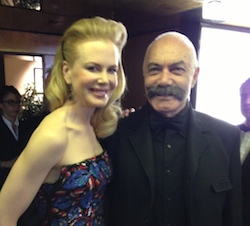(Italian: L’Albero degli zoccoli)
Ermanno Olmi’s epic Italian feature, which he wrote, directed, photographed, and edited, was a major artwork that swept the film festival and art-house circuits in 1978.
Grade: A (***** out of *****)
| Wooden Clogs | |
|---|---|

Original film poster
|
|
The Tree of Wooden Clogs (Italian: L’Albero degli zoccoli) is a 1978 Italian film written and directed by Ermanno Olmi. The film concerns Lombard peasant life in a cascina (farmhouse) of the late 19th century. It has some similarities with the earlier Italian neorealist movement, in that it focuses on the lives of the poor, and the parts were played by real farmers and locals, rather than professional actors.
Inspired by the ethnological studies of the seminal American documentarian, Robert Flaherty, it presented an ultra-realistic (cinema verite style) of peasants’ life.
The film is about the life inside a farm in northern Italy at the beginning of the 19th century. Many poor country families live there, and the owner pays them by their productivity.
The narrative focuses on three families, whose peasant members are played by nonprofessional actors.
One of the families has a very clever child, and they decide to send him to school instead of forcing him to help them, although this represents a great sacrifice of all concerned. For one thing, the boy has to wake up very early each morning and walk several miles to the school. One day, the boy’s shoes break when returning home, but they do not have money to buy another one.
In his various capacities, Olmi refuses to moralize or sentimentalize the ordinary existence of his protagonists, who work diligently and with utmost care and commitment, though clearly he admires it. Interestingly, Olmi does not dwell enough on the potential (and real) social class conflict between the farmers and the (absent) landlord who owns and governs the land.
Taking a memorable, lyrical look at ordinary life, the film achieves the kind of greatness that Rossellini and other neo-realist directors had accomplished.
The movie depicts in an objective yet compassionate way the hardships of daily survival experienced by ordinary people.
All of Olmi’s films are humanistic and reflective, portraying everyday people in particular landscapes and locations, while at the same time being charged with social comment and poetic flashes.”
The Tree of Wooden Clogs won numerous awards, including the Palme d’or at Cannes and the César Award for Best Foreign Film. It broke records in Cannes, when it became the second film in a row (after “Padre Padrone,” by the Taviani brothers, in 1977) to win the top jury prize.
The only aspect of the production which Olmi had not done is compose the score. The narrative is accompanied by the music of Johann Sebastian Bach.
The original version of the movie is spoken in Lombard (the Bergamasque variety, an Eastern Lombard dialect).
Credits:
Running time: 185 Minutes
Release dates: Sept 21, 1978 (Italy); June 1, 1979 (U.S.)










